
Seamless Integrations: How AI Bridges Diverse Software Platforms
Discover how AI technologies are enhancing the integration processes across multiple software platforms. This blog delves into innovative methods that AI employs to ensure seamless communication between disparate systems, ultimately leading to optimized workflows and better scalability.
In today's interconnected digital world, the demand for diverse software platforms to communicate efficiently is more prominent than ever. However, integrating these systems has always been a challenging task. Enter Artificial Intelligence—the game-changer poised to revolutionize how we think about software integration.
AI offers unprecedented capabilities in understanding, learning, and processing data. When applied to software integration, AI can significantly streamline the traditionally complex and time-consuming process, transforming it into a seamless, efficient, and error-free operation.
-
Automated Data Mapping: AI automates the data mapping process by intelligently analyzing structures, detecting patterns, and suggesting optimal pathways for data exchange. This reduces reliance on manual configuration, which is often prone to error and inconsistencies.
-
Intelligent Error Resolution: AI systems can predict potential errors and propose solutions before they impact the integration process. By using historical data and machine learning algorithms, AI minimizes downtime and boosts system reliability.
-
Dynamic Adaptation: AI can dynamically adapt integration processes to accommodate changes in either platform, ensuring continuous operation even when updates or modifications are implemented on either end.
-
Enhanced Security: By employing AI algorithms, integration processes are fortified with enhanced security measures, detecting and mitigating potential threats and breaches in real-time.
-
Scalability: As organizational needs grow, AI-powered integrations can easily scale, supporting a growing number of connections and data throughput without degradation of performance.
-
Natural Language Interfaces: Simplifying the interface through which integrators interact with AI systems, natural language processing enables non-technical users to engage with and manage integration workflows effectively.
As businesses seek to leverage diverse systems to remain competitive, AI-driven integration solutions present an opportunity to stay ahead of the curve, offering robust, adaptable, and secure software ecosystems. The future of software integration lies in embracing these AI advancements, which promise to relinquish barriers and unlock the true potential of interconnected software platforms.